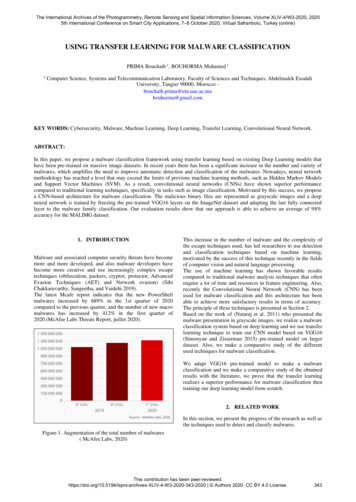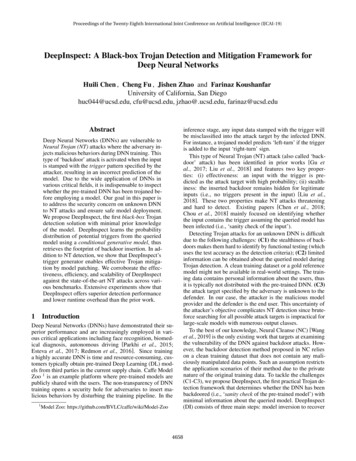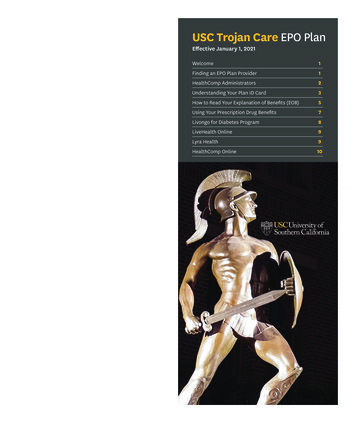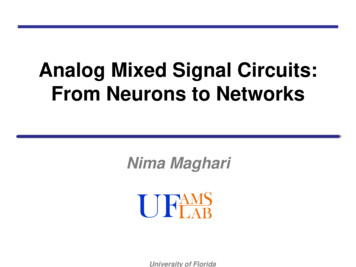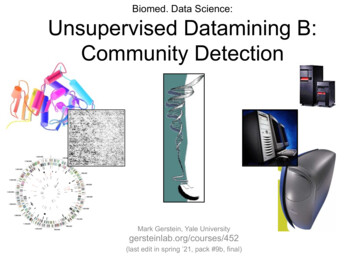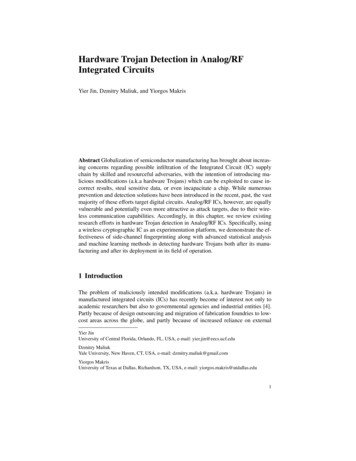
Transcription
Hardware Trojan Detection in Analog/RFIntegrated CircuitsYier Jin, Dzmitry Maliuk, and Yiorgos MakrisAbstract Globalization of semiconductor manufacturing has brought about increasing concerns regarding possible infiltration of the Integrated Circuit (IC) supplychain by skilled and resourceful adversaries, with the intention of introducing malicious modifications (a.k.a hardware Trojans) which can be exploited to cause incorrect results, steal sensitive data, or even incapacitate a chip. While numerousprevention and detection solutions have been introduced in the recent, past, the vastmajority of these efforts target digital circuits. Analog/RF ICs, however, are equallyvulnerable and potentially even more attractive as attack targets, due to their wireless communication capabilities. Accordingly, in this chapter, we review existingresearch efforts in hardware Trojan detection in Analog/RF ICs. Specifically, usinga wireless cryptographic IC as an experimentation platform, we demonstrate the effectiveness of side-channel fingerprinting along with advanced statistical analysisand machine learning methods in detecting hardware Trojans both after its manufacturing and after its deployment in its field of operation.1 IntroductionThe problem of maliciously intended modifications (a.k.a. hardware Trojans) inmanufactured integrated circuits (ICs) has recently become of interest not only toacademic researchers but also to governmental agencies and industrial entities [4].Partly because of design outsourcing and migration of fabrication foundries to lowcost areas across the globe, and partly because of increased reliance on externalYier JinUniversity of Central Florida, Orlando, FL, USA, e-mail: yier.jin@eecs.ucf.eduDzmitry MaliukYale University, New Haven, CT, USA, e-mail: dzmitry.maliuk@gmail.comYiorgos MakrisUniversity of Texas at Dallas, Richardson, TX, USA, e-mail: yiorgos.makris@utdallas.edu1
2Yier Jin, Dzmitry Maliuk, and Yiorgos Makrishardware intellectual property (IP) and Electronic Design Automation (EDA) software from various vendors, the integrated circuit supply chain is now consideredfar more vulnerable to such malicious modifications than ever before. Fears thatskillful and resourceful adversaries may be able to compromise some stage of ICdesign and/or fabrication and insert Trojan hardware are becoming increasingly intense, as rumors about actual occurrence of such cases surface [4]. In essence, thefundamental concern is that hardware Trojan-infested chips may be capable of additional functionality which is unknown to the designer/vendor/customer and whichcan be exploited by the perpetrator after chip deployment. Evidently, depending onthe field of application, the consequences of such attacks may range from minorinconvenience to major catastrophic events, especially since the intended target ofsuch dubious ICs will most likely be a sensitive domain, such as financial, military,or other vital infrastructure.While the severity of the potential implications of such a threat has fueled several research efforts towards better understanding and dealing with hardware Trojans both at the pre-silicon [39, 24, 22, 27, 18, 16, 15, 14] and at the post-silicon[34, 33, 40, 35, 20, 26, 25, 8, 10, 7, 6, 12, 9, 31, 32, 36] stage, the vast majority ofthese efforts target traditional digital circuits. In contrast, this chapter will focus onthe problem of hardware Trojans in the analog/RF domain and will also introducehardware Trojan detection methods for wireless ICs. Similar to digital circuits, analog/RF ICs are now prevalent in electronic systems, facilitating industrial controland wireless communication and becoming an inseparable part of modern everyday activities. At the same time, analog/RF ICs (and, by extension, the integratedsystems containing analog/RF modules) are particularly vulnerable and constitutea very appealing target for hardware Trojan attacks; indeed, since such circuits receive and transmit information over public wireless channels, the attacker does notneed to obtain physical access to their input/output space, making such attacks farmore realistic. Moreover, most modern communication systems employ some formof encryption in order to protect the privacy of the information that is communicated over the public channel. Interestingly, while this provides the user with an–often misleading– sense of security, it also entices attackers, who know that valuable secret information (e.g. the encryption key) is stored on these devices. Therefore, development of pertinent Trojan hardware mitigation methods for analog/RFICs is equally (if not more) critical as with their digital counterparts.Toward this end, this chapter studies the threat of hardware Trojans specificallywithin the context of analog/RF ICs and examines remedies to ensure their trustworthiness both during the manufacturing testing process and after their deployment intheir field of operation. Through the material introduced in this chapter we seek toachieve the following objectives: Delineate the threat and potential impact of hardware Trojans in analog/RF ICs.Specifically, we will focus on vulnerability introduced by the margins that aretypically allowed in the transmission parameters in order to deal with processvariations and we will show that these margins can be exploited in order togain control of a chip and/or leak sensitive information. The trade-off betweenthe level of harm that these hardware Trojans may incur and the impact on
Hardware Trojan Detection in Analog/RF Integrated Circuits3area/power/performance, which is strongly correlated to their detection susceptibility, will also be investigated. Elucidate the shortcomings of existing test methods in exposing hardware Trojans in the analog/RF IC domains. Since analog/RF Trojans do not change thefunctionality of the chip, they are very difficult to be detected by traditional manufacturing testing methods. The effectiveness of existing hardware Trojan detection methods introduced in the digital domain will also be investigated. Devise efficient hardware Trojan detection methods based on statistical analysisand machine learning, specifically for analog/RF ICs. The effect of a carefullydesigned hardware Trojan is expected to be hidden within the parametric designmargins, making side channel information of a Trojan-infested chip appear perfectly legitimate if examined in isolation. However, for the hardware Trojan to beof utility to the attacker, it needs to impose some form of structure in the transmission signals and/or other side-channel signals, through which remote commandswill be issued or secret information will be leaked. Statistical analysis methodscan therefore be used to detect the existence of this added structure and machinelearning (i.e. trained classifiers) can be used to distinguish between Trojan-freeand Trojan-infested chip populations.2 Hardware Trojans in Wireless ICsUsing as an experimentation vehicle a simple wireless cryptographic circuit and twoexample hardware Trojans which were specifically designed to attack wireless ICs[21], we will demonstrate the following three key findings: Attack Complexity: Minor modifications to a wireless cryptographic chip suffice to leak secret information. The vulnerability of such chips stems partly fromthe fact that they transmit over a public wireless channel. Their true Achillesheel, however, is the fundamentally analog nature of a wireless transmission,which entails several continuous parameters (e.g. amplitude, frequency, phase,etc.). In order to tolerate variations due to fabrication process and/or operatingconditions, specifications for these parameters are defined as windows of acceptable performances rather than exact values. As a result, a hardware Trojan canhide additional information within the tolerance margins of such continuous entities and secretly transmit it. While such transmissions abide by all specificationsand appear to be perfectly legitimate, an adversary who knows the structure ofthe additional information will be able to extract it. Detection Difficulty: Evading detection by traditional manufacturing test methods is trivial. The functionality of the digital part of the chip in normal operationmode and in test mode can be preserved despite the addition of the hardware Trojan; hence, no structural (i.e. scan-based) or functional tests (or even enhancedfunctional tests for hardware Trojan-detection) will fail in a fault-free but Trojaninfested chip. Similarly, since the analog functionality of the chip is left intact,
4Yier Jin, Dzmitry Maliuk, and Yiorgos Makrisall analog/RF specification tests will pass. Furthermore, since the leaked information is hidden within the allowed transmission specification margins, systemlevel functional tests will also pass. Existing side-channel fingerprint generationand checking methods, at least in their original form, also fall short in detectinghardware Trojans in wireless cryptographic ICs. Possible Solution: Despite the fact that hardware Trojans can be hidden withinthe process variation margins of a wireless cryptographic chip and may not beexposed through any of the above methods, it may still be possible to detectthem. Effective hardware Trojans must impose a specific structure on the transmission parameters, which the attacker leverages to snoop the secret key. Whilethis structure is not known to the defender, advanced statistical analysis of theseparameters may be sufficient to reveal its existence and, thereby, expose the hardware Trojan. Since the attacker does not know what data will be collected or howit will be analyzed, this method is difficult to evade. In other words, the element of surprise by the attacker, who picks the structure of the hidden data, iscounteracted by a similar element of surprise by the defender, who picks themeasurements and the statistical analysis method.3 Pre-Deployment Hardware Trojan DetectionThe most common threat model adopted in hardware Trojan research assumes thatthe culprit is either at the foundry or at design houses where third party intellectualproperty (IP) is acquired from. In either case, once silicon is obtained and beforeit is shipped to customers, it is essential to test not only for manufacturing defects(which is the objective of VLSI testing) but also for hardware Trojans. Therefore, wefirst discuss the problem of pre-deployment hardware Trojan detection in analog/RFICs, wherein we can exercise the device under test in a controlled environment withpre-specified stimuli.3.1 Experimentation VehicleThe experimentation vehicle used to elucidate the problem of hardware Trojans inanalog/RF ICs is shown in Figure 1. This is a mixed-signal wireless cryptographicIC, capable of encrypting and broadcasting data, which can be used in secure datatransmission over open channels. The digital part includes a pipelined Digital Encryption Standard (DES) core [2], an output buffer and a serializer, which serves asthe interface between the digital and the analog part. The analog part is an UltraWide-Band (UWB) transmitter.The DES core in the chip is a performance-optimized design with 16 encryption blocks in a pipeline structure. Each block can independently run the Feistelfunction f , which is the central part of the DES algorithm. A fully pipelined key
Hardware Trojan Detection in Analog/RF Integrated Circuits5Fig. 1 Block diagram of example wireless cryptographic integrated circuitFig. 2 Example of 64-bit ciphertext block transmissiongeneration module is designed to operate in parallel with these encryption blocks.In order to achieve high operating frequency, the initial permutation and inverseinitial permutation of the plaintext are handled through hard-wiring, with no logiccircuitry involved. The widths of the input and output data are both 64 bits, whichis the length of a plaintext/ciphertext block. The output buffer is a First-In FirstOut (FIFO) structure of 64-bit words, which supports reading and writing speedscommensurate with the performance of the pipelined DES core. The digital/analoginterface converts the 64-bit data block from the buffer into a serial bit stream andpasses it on to the UWB transmitter. The interface also adjusts the data-sending frequency to ensure signal integrity in this mixed-signal design. A pulse on the sendprimary input passes the contents of the output buffer to the interface and finally tothe UWB transmitter for broadcasting. The UWB transmitter [41] consists of a pulsesignal generator, a gating signal generator and two driver amplifiers (DAs) and cantransmit data over a wide spectrum of frequency bands with very low power consumption and high data rate. The UWB transmitter is in active mode and transmitsa high frequency signal when the information bit to be transmitted is ‘1’, otherwiseit is in idle mode.The chip is designed in TSMC CL013G .13µm CMOS technology process [1].The digital part runs at a frequency of 75MHz and the UWB transmitter has a datarate that exceeds 50Mbps. Tests for the digital part cover both stuck-at and delayfaults using a full-scan chain of Enhanced Scan Flip-Flops [17]. For the analog part,
6Yier Jin, Dzmitry Maliuk, and Yiorgos Makrisbesides the traditional specification tests, the spectrum of the output pulse sequenceof the DA chain at a data transmission rate of 50Mbps is also measured [41]. Systemlevel functional tests involve randomly generated patterns which are encrypted andbroadcasted by the UWB transmitter. A receiver decrypts the ciphertext and compares to the expected plaintext, in order to detect any discrepancies.Figure 2 shows a simulation example of a typical transmission of a 64-bit blockof ciphertext and a magnified view of the transmission signal when a ‘1’ bit is broadcasted. UWB specification calls for a transmission frequency between 3.1GHz and10.6GHz. The specifications for this particular implementation define its frequencybetween 4GHz and 6GHz. Transmitting a ‘1’ bit involves between 5 and 7 peaksof amplitude over 300uW with at least one of them over 900uW. The actual performances of each individual chip will vary, depending on the fabrication processvariations. For example, the response of the circuit instance shown in the figure,which was randomly picked from a population of 200 chips generated through aMonte Carlo Spice simulation with 5% process variation on all transistor parameters, operates at a frequency of 4.8GHz and involves 5 peaks of amplitude over300uW with the largest measuring at 1114uW.3.2 Hardware TrojansTwo hardware Trojans are designed which, through minute modifications, are capable of leaking the encryption key by hiding it in the wireless transmission parameter(i.e. amplitude or frequency) margins allowed in the design specifications in orderto deal with process variations. Thus, they ensure that the circuit continues to comply to all of its functional specifications. The working principle of these Trojans issimple: extract one bit at a a time from the 56-bit encryption key, which is stored inthe DES core, and leak it by hiding it in one 64-bit block of transmitted data. After56 ciphertext blocks are transmitted, the entire key will have been broadcasted.Implementation Details: Each hardware Trojan involves two modifications. Thefirst modification, which is shown in Figure 3(a), is common to both hardware Trojans and aims to extract the encryption key from the DES core. The second modification, which is shown in Figure 3(b), is different for each of the two hardwareTrojan and aims to manipulate the transmission amplitude or frequency in order toleak the key through the wireless channel.The key extraction modification exploits the ability of Enhanced Scan Flip-Flopsto store two bits, one in the D flip-flop and one in the follow-up latch, so that backto-back vectors can be applied for the purpose of detecting delay faults when thecircuit is in test mode [17]. During normal operation, however, the latches are transparent, essentially holding the same information as the D flip-flops. In the examplecircuit, the 56-bit encryption key is stored in a sequence of 56 Enhanced Scan FlipFlops which are serially connected in a scan chain, as shown in the top part of Figure 3(a). The basic idea for extracting the secret key is to store it only in the latchesof the Enhanced Scan Flip Flops and reuse the D flip-flops to create a 56-bit rota-
Hardware Trojan Detection in Analog/RF Integrated Circuits7Fig. 3 (a) Extracting the key bitwise, through a rotator made out of the 56 enhanced scan flipflops where it is stored, (b) Broadcasting the stolen key bit by manipulating the amplitude or thefrequency of the UWB transmissiontor. Initially, when the key is loaded by the user, both the flip-flops and the latcheshold the correct bits. Then, every time a data block is transmitted, the last bit of thisrotator is extracted and hidden in the transmission, while the rotator shifts its contents by one position. Only the D flip-flops of the Enhanced Scan Flip Flops hold arotated version of the key, while the follow-up latches continue to hold the correctversion, so that the ciphertext is correctly produced. Simple control logic consistingof a few gates, shown in red color in the bottom part of Figure 3(a), suffices for thispurpose.The key transmission modification receives the stolen bit and based on its valuemodifies the transmission signal in one of two ways. The first option (Type-I), shownon the left side of Figure 3(b), manipulates the transmission amplitude; when thestolen key bit is ‘1’, an additional driver strengthens the legitimate transmissionsignal before it reaches the gating generator, thereby slightly increasing the transmission amplitude. Figure 4(a) shows the corresponding impact on the signal transmitted by the example circuit instance used in Figure 2. In this case, the amplitudeincreases from 1114uW to 1235uW, but the frequency remains at 4.8GHz. The second option (Type-II), shown on the right side of Figure 3(b), manipulates the transmission frequency; when the stolen key bit is ‘1’, the original buffer is bypassedand an alternative buffer is used to delay the output of the pulse generator, therebyslightly increasing the transmission frequency. Figure 4(b) shows the correspondingimpact on the signal transmitted by the example circuit instance used in Figure 2.In this case, the frequency increases from 4.8GHz to 5.2GHz but the amplitude remains at 1105uW. In both cases, when the stolen key bit is ‘0’, no change occurs inthe transmitted signal.
8Yier Jin, Dzmitry Maliuk, and Yiorgos MakrisFig. 4 (a) Difference in Type-I Trojan-infested circuit transmission depending on value of stolenkey bit, (b) Difference in Type-II Trojan-infested circuit transmission depending on value of stolenkey bitThe overall area overhead incurred by each of the above Trojans is around 0.02%of the digital part of the chip. This figure assumes that the storage elements holdingthe secret key are Enhanced Scan Flip Flops which are connected in sequence. Ifthis is not the case and a separate 56-bit rotator needs to be added, the area overheadstill remains well below 0.4% of the digital part of the chip.Secret Information Extraction: Figures 4(a) and (b) show the transmission powerwaveform of a Type-I and a Type-II Trojan-infested chip, respectively, when thestolen key bit transmitted along with the legitimate signal is ‘1’, as well as whenit is ‘0’. Evidently, in the Type-I Trojan-infested chip, the difference in the stolen
Hardware Trojan Detection in Analog/RF Integrated Circuits9key bit value is reflected as a difference of 120uW in the maximum amplitude.Similarly, in the Type-II Trojan-infested chip, the difference in the stolen key bitvalue is reflected as a 0.4GHz difference in the frequency. Both of these differencesare well within the margins allowed for process variations and operating conditionfluctuations and would not raise any suspicion. While the attacker does not knowa priori the exact amplitude or frequency levels in each of the two cases, the factthat this difference is always present suffices for extracting the secret key. All theattacker needs to do is listen to the wireless channel to observe these two differentamplitude or frequency levels, which correspond to a stolen key bit of ‘1’ and astolen key bit of ‘0’, respectively. Once these two levels are known, listening to56 consecutive transmission blocks reveals a rotated version of the 56 bits of theencryption key. Using this information, the attacker needs at most 56 attempts (i.e.all rotations of the extracted 56 bits) to decrypt the transmitted ciphertext.3.3 Evaluation of Existing Test and Trojan Detection MethodsThe mechanism through which the two hardware Trojan examples leak the secretinformation over the wireless channel allows them to evade detection not only bytraditional manufacturing testing but also from previously proposed Trojan detectionmethods.Functional, Structural, and Enhanced Testing: The hardware Trojan examples donot alter the functionality of the digital part of the circuit. In normal operation, theenhanced scan flip-flops that hold the key bits are loaded appropriately. Numerousrandomly generated functional test vectors are simulated to verify the correctnessof the produced ciphertext. In test mode, the scan chain also operates as expected.To demonstrate that structural tests do not detect these hardware Trojans, a standardindustrial ATPG tool is used to generate test vectors for all stuck-at and delay faultsin the Trojan-free circuit. These tests are simulated on the two Trojan-infested circuits. As expected, all tests passed. Enhancing the test set with further vectors thatexercise rare events [40, 35] is also ineffective, since the hardware Trojans do notaffect the digital functionality. The analog portion is not modified and, therefore, italso passes the traditional specification-based analog/RF test.System-Level Testing: System-level tests examining the parameters of the wireless transmission also fail to expose the hardware Trojans, since the structure addedby the leaked information is hidden within the margins allowed for process variations. To demonstrate this, we measured the transmission power of 200 genuine(i.e. Trojan-free) chips, 100 chips infested with a Type-I hardware Trojan and 100chips infested with a Type-II hardware Trojan, which we generated using MonteCarlo Spice-level simulation assuming 5% process variations on all circuit parameters. Figure 5(a) plots the transmission power when a ‘1’ is transmitted by half ofthese chips, as well as the µ 3σ envelope of the transmission power when a ‘1’is transmitted by the other half of these chips. Figures 12(b) and (c) plot the transmission power when a ‘1’ is transmitted by the Type-I and Type-II Trojan infested
10Yier Jin, Dzmitry Maliuk, and Yiorgos MakrisFig. 5 (a) µ 3σ transmission power envelope of 100 Trojan-free chips and transmission powerof another 100 Trojan-free chips, (b) Transmission power of 100 Type-I Trojan-infested chips, (c)Transmission power of 100 Type-II Trojan-infested chipschips, respectively. Evidently, given any one of these transmission power plots, it isnot possible to distinguish whether it comes from a Trojan-free or a Trojan-infestedchip.Local Current Traces: An interesting hardware Trojan detection method based onlocal current traces is presented in [33, 34]. This test strategy detects anomalies introduced by the Trojan in the currents measured at the power ports and takes intoaccount process and operating conditions variations. The authors demonstrate thattheir method can detect Trojans of size as small as 2% of the power grid. In order
Hardware Trojan Detection in Analog/RF Integrated Circuits11to implement this method in the design, the chip needs to be divided into at least 20power grids with at least 30 uniformly located power ports. The availability of thesepower ports is a serious obstacle to implementing this method. Furthermore, a capable attacker would probably observe the existence of these power ports and couldpossibly invent countermeasures to prevent the injected hardware Trojans from becoming visible through these ports.Global Power Traces: In [5], the authors use global power consumption tracesto distinguish between Trojan-free and Trojan-infested chips. The method employsstatistical analysis of the Eigenvalue spectrum and can effectively detect hardwareTrojans occupying 0.12% of the total circuit area, assuming process variation inthe order of 5%. But when the hardware Trojan area is reduced to only 0.01% andthe process variation is increased to 7.5%, false alarms start to appear. Consideringthe very low area overhead of the hardware Trojans (i.e. 0.02%) and based on thelimitations outlined in [5], it is unlikely that statistical analysis of the total powerconsumption will expose them. Indeed, even when this method is applied to thepower traces of the digital part only1 , wherein the hardware Trojans are hidden, itwas not possible to effectively distinguish between Trojan-free and Trojan-infestedchips in any Eigenvalue sub-space. Nevertheless, as mentioned in [5], other parameters may still prove effective. In fact, the solution used in the following sectionemploys a similar statistical analysis of the wireless transmission power.Path Delay Traces: A similar statistical method proposed in [20] utilizes path delayfingerprints to differentiate Trojan-free from Trojan-infested chips. While the hardware Trojan examples add some delay to a small number of paths in the digital partof the circuit, the impact is too small to be observed. Even if those paths related tothe encryption key are checked, the complexity of the pipelined encryption circuitryprovides enough margin to hide the added delay. To verify this, the path delay basedTrojan detection method was applied assuming process variations in the range of5% but it was unable to identify the existence of hardware Trojans.3.4 Statistical Analysis to the RescueWhile the structure added to the transmitted signal for the attacker to extractthe stolen key leaves individual transmissions within the acceptable specificationboundaries, it enables the possibility that such hardware Trojans can be exposedthrough statistical analysis of the transmission parameters.To demonstrate this principle, a measurement the total transmission power is usedfor broadcasting one block of data (i.e. 64-bits). For 100 Type-I Trojan-infected, 100Type-II Trojan-infected, and half of the 200 Trojan-free circuit instances which aregenerated via Monte Carlo simulation with 5% process variations, the total transmission power is measured when transmitting each of six randomly selected blocks(the same for all circuits). Of course, the Trojan-infested chips also leak one key1Mixed-signal SoCs typically have separate power ports for the analog and the digital parts.
12Yier Jin, Dzmitry Maliuk, and Yiorgos MakrisFig. 6 (a) Projection of genuine and Trojan-infested chip populations on three out of six transmission power measurement, (b) Projection of genuine and Trojan-infested chip populations on threeprincipal components of six transmission power measurementsbit during each of the six transmissions, half of which are set to ‘1’. All six measurements for all genuine and all Trojan-infested chips are within the acceptablespecification range. Even when the three chip populations are projected on the sixdimensional space of these measurements, it is impossible to distinguish them sincethey fall upon each other. Figure 6(a) shows a projection of the three populationson three of these dimensions. Evidently, separating the genuine from the Trojan-
Hardware Trojan Detection in Analog/RF Integrated Circuits13infested populations in this space is not possible. The situation is similar for anyother subset of three measurements.However, running a Principal Component Analysis (PCA) on these measurements reveals that the structure of the genuine chip data is different than the structureof the Trojan-infested chip data. Figure 6(b) shows a projection of the three populations on the three principal components of the data, clearly revealing that theyare separable in this space. Therefore, the trusted boundary is defined as a simpleminimum volume enclosing ellipsoid (MVEE [30]) which encompasses the genuine population. Then, any chip whose footprint on the space of the selected threeprincipal components does not fall within the trusted boundary will be discardedas suspicious. In the example, this method detects all Type-I and Type-II Trojaninfested chips without inadvertently discarding any genuine chips.Given the small number of transmission parameters (or combinations thereof)wherein the attacker can hide the added structure, as well as the large number ofmeasurements that the defender can utilize to identify statistical discrepancies, thedefender can easily detect the inserted hardware Trojan. Finally, similar statisticalanalysis and machine learning-based methods involving parametric measurementshave been previously employed successfully for the purpose of manufacturing testing [38] and radiometric fingerprinting [11] of analog/RF circuits. However, this isthe first attempt to apply such methods towards hardware Trojan detection in wireless cryptographic ICs or aanalog/RF ICs in general.4 Post-Deployment Hardware Trojan DetectionWhile the aforementioned side-channel fingerprinting method can be very effectivein detecting hardware Trojans prior to IC deployment, it relies on the assumptionthat the Trojan is active at test time. Hence, it fails to detect dormant hardware Trojans which are activated only after an IC is deployed in its field of operation, througha lapsed-time counter or an external trigger [19]. Therefore, continuing to evaluatetrustworthiness after deployment through on-chip support for hardwa
the problem of hardware Trojans in the analog/RF domain and will also introduce hardware Trojan detection methods for wireless ICs. Similar to digital circuits, ana-log/RF ICs are now prevalent in electronic systems, facilitating industrial control and wireless communication and becoming an inseparable part of modern every-day activities.
